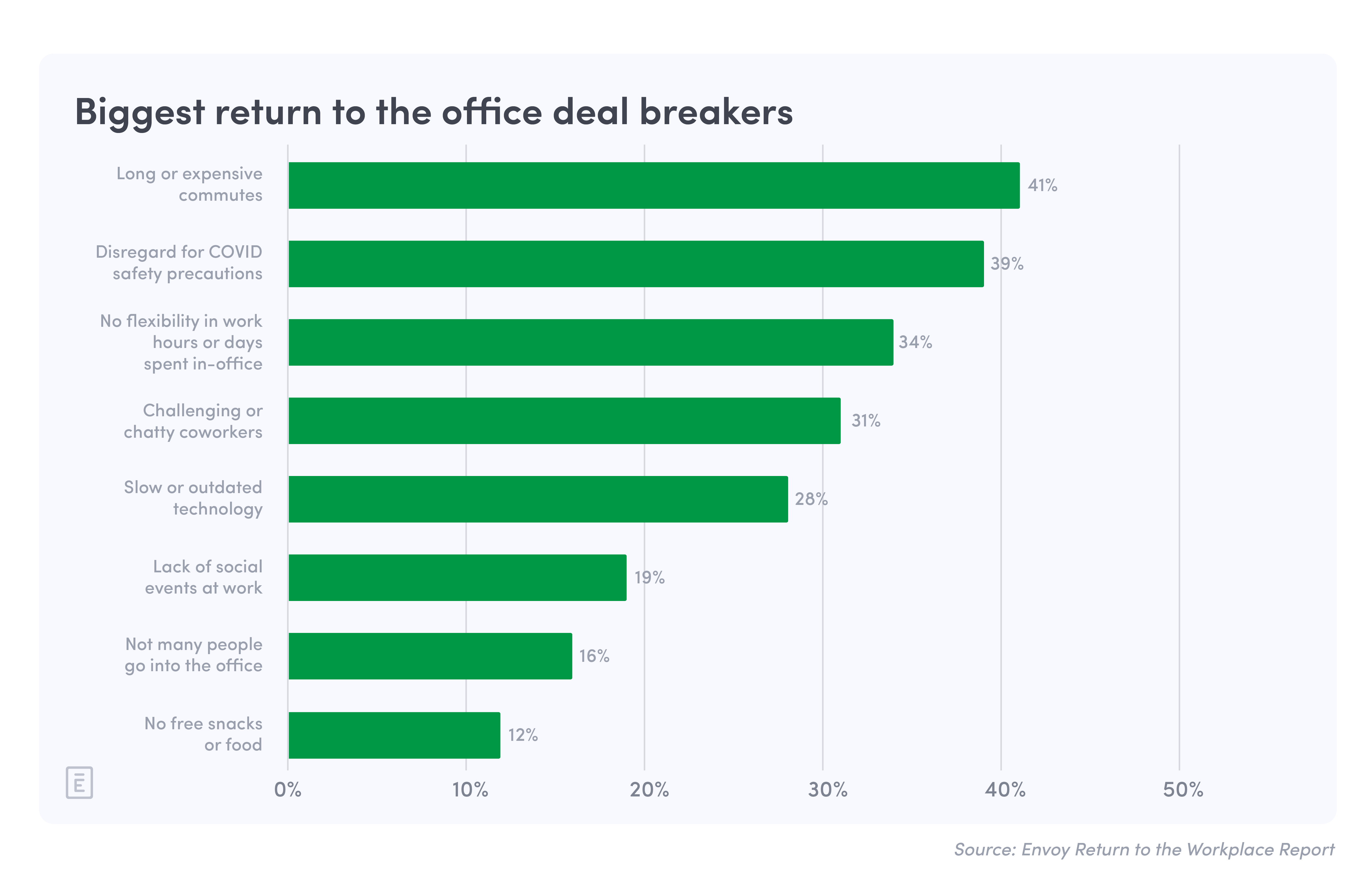Some office workers have returned to the workplace and some have not. But whether they’ve made the leap or hope to do so soon, both groups have strong opinions on what it takes to go from home to office. In the latest Return to the Workplace Report, they’re speaking out. Flexibility is top of mind—and just may be the key.
Employees want flexibility—just as much as than other benefits
Employees expect more from their companies during this pandemic. So we asked them: what would empower you? Which benefits, if any, would make a difference whether you stay or go? Workplace leaders, take note: 63% of employees say flexibility would make them feel more empowered. Nearly half agree that having the freedom to split time between the workplace and home, and the flexibility to choose which days to come in, are just as important as traditional benefits like matching 401(k)s and paid time off.

Folks are more comfortable with workplace vaccination requirements
66% of office workers say their company verifies vaccination status or weekly COVID test results, and among them, the vast majority (81%) are comfortable with it.Two-thirds of those who work for companies that verify COVID vaccination status or testing feel more comfortable returning to work. That number drops to fewer than half (49%) for employees from companies that don’t verify status.Comfort levels with vaccination verification vary by generation. While 78% of Gen Z are pleased by these policies, only 55% of Boomers say the same. Covid vaccination policies may also be a motivating factor: 85% of employees are more likely to go into an office that verifies vaccination status or weekly test results.
Socializing tops the list of what gets folks excited to be in the office
95% of those surveyed feel there is at least one thing that really excites them about working in the office. Impromptu social interactions with colleagues tops the list (48%).

Women (52%) are more excited about the relationship building that comes from social interactions compared to their male counterparts (44%).The biggest return to work deal breakers are long or expensive commutes (41%). Other deal breakers include: a disregard for COVID safety precautions (39%), no flexibility in work hours or days spent in-office (34%), and dealing with challenging or chatty coworkers (31%).

Despite fielding this survey when people were at their most optimistic (post-Delta surge and pre-Omicron), there are valuable lessons to be learned. While COVID variants may come and go, given time, most people will gravitate back to the workplace. Either one, two, or three days a week. 61% said back in late November that they’re actually more comfortable going into the office compared to six months ago (in the summer of 2021). Even among those who have worked exclusively from home since the pandemic, an overwhelming majority (91%) intend on returning to the workplace at some point. Only 8% felt more uneasy. Among those who have already returned, 85% say the experience has exceeded their expectations. Of those who are more comfortable returning, 46% say it’s because they trust that their company is prepared to keep them safe. 39% feel they do their best work in-office while the same percentage trust in the fact that their household has been vaccinated. People are aching for community. What’s drawing them back to the workplace are in-person interactions that make socializing and work collaboration so much easier. That said, they want their autonomy too. They want control over when and how they come back.As workplace leaders, you know what employees want. You also know how to make their workplace experience better. Now, it’s time to make it a reality. Companies that have figured this out and make it a priority will do well.
Methodology
Envoy partnered with Wakefield Research to survey 1,000 full-time U.S. employees over the age of 18, employed full or part-time. Survey responses were collected between November 24 and December 1, 2021, using an email invitation and an online survey. The data has been weighted to ensure reliable and accurate representation of US office workers who have returned to the office. The overall margin of error for the findings is ±3.1% at a 95% confidence level.
Read more
Searching for a visitor management solution? Learn what to look out for and how to choose the best tech for your team.
Managing your space well doesn’t have to be difficult. But if you want to be successful, you need the right approach.
A well-run workplace can set your team up for success. Learn why workplace management matters and how to do it right.
Workplace security is critical to the future of your business. Learn why it matters, what threats to watch for, and how to strengthen your workplace security plan.
In this post, we’ll explore what workplace compliance is and how to build a compliance culture for your organization.
With more folks sending personal packages to the workplace, having a sound mailroom management system in place is key.










